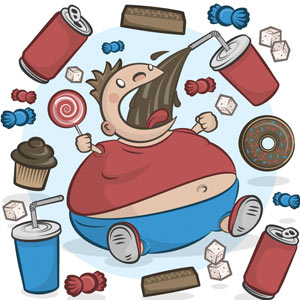Tackling Childhood Obesity

Our Children’s Health in Danger
Medical school education in the early ‘80s did not tell us much about diabetes, high blood pressure, osteoporosis, high cholesterol, or sleep apnea in children. The new obesity epidemic, with poor diets and lack of consistent exercise routines, has made our children and youth vulnerable to premature mortality, to ailments that were usually diseases of the aging population.
Not recognizing the problem is a huge barrier to making progress. Parents who are overweight seem to blame the issue on genetics. Often, being overweight is considered a sign of prosperity and referred to as ‘healthy’ in our desi culture. Sometimes parents think their kids will outgrow this phase as they grow older, only to discover that the problem worsens when they head to college. The lack of physical education in public schools may be partly to blame and poor choices of lunch programs can be another hurdle. Schools attempting to serve unprocessed foods and fresh fruits and vegetables are frequently met with rebellious parents and kids who wish to continue the old bad habits.
I was shocked when a parent logged in 3,000 calories a day, when their middle schooler made a partial list of what she ate daily. An epidemiologist at one of the Adult and Pediatric Lipid clinics in Detroit recommends that pre-puberty children should consume no more than 2,000 calories a day. Girls in high school should consume no more than 1,500 calories a day, and boys about 2,000. Those engaged in aggressive sports should add an extra 300 calories a day.
Why is this important? Well, there must be some reason if First Lady Michelle Obama took on tackling childhood obesity as her mission. Here is a short summary of why I think this needs the serious attention of any parent:
HEART DISEASE currently is our number one enemy, taking away huge numbers of resources and dollars that could be used for clinical research in cancer and Alzheimer’s, which are two noncommunicable diseases that are recognized as morbid conditions of our century. Pediatricians are encouraged to check lipid profiles for their patients at age 9 through 11 and then again in their precollege years. College and university life pose great lifestyle changes, often encouraging weight gain in almost 80 percent of students.
DIABETES TYPE 2 was almost never reported in children but is now reaching an epidemic proportion, causing many pediatricians to worry about premature heart disease, nerve damage, vision loss, and early Alzheimer’s. Early recognition of prediabetes with aggressive change in lifestyle, weight loss, and exercise programs can prevent full-blown diabetes.
HYPERTENSION is an equal partner to Type 2 diabetes, contributing to kidney, brain, and heart damage. Early diagnosis, with alteration in diet and lifestyle, can reverse the condition.
FATTY LIVER is a primary cause of liver failure. Obese children eating high caloric diets develop high sugars. The liver enters the picture by wanting to drop the sugar, converting the sugar into fat and reserving it in the liver, leading to a frightening condition of fatty liver. It keeps the fatty acids but throws the triglycerides into the blood system. This leads to liver function sluggishness and premature heart disease. It is not unusual to see heart disease present in youth as early as in their 30s. Any child who has a Body Mass Index in the 30 range must seek early cardiology consultation. Early intervention may prove to be life saving.
OSTEOPOROSIS, as a result of children not getting enough dairy products and not exercising or playing sports outside like they used to, leads to poor bone formation. Their bone structures are weak, predisposing them to fractures in adulthood.
Prevention is the best medicine. Eating fresh fruits and vegetables, minimizing processed foods, and getting plenty of exercise, and most importantly, maintaining an ideal BMI early on in life, leads to a habit of children accepting these lifestyle norms as their best lifetime assets. Whole wheat breads, whole wheat pastas, and whole wheat tacos are preferred over high starches like foods made of white flour, white pastas, white tacos, white potatoes, white rice, and sugars.

[Gulshan Harjee, M.D., is a board certified internist in private practice with an emphasis on prevention. Please email your health and medical questions for consideration in this column to: gharjee@comcast. net. The material in this column is of a general nature, and must not be construed as specific medical advice. This column rotates monthly along with the Fitness Lifestyle column by Aarti Patel.]
Enjoyed reading Khabar magazine? Subscribe to Khabar and get a full digital copy of this Indian-American community magazine.
blog comments powered by Disqus










